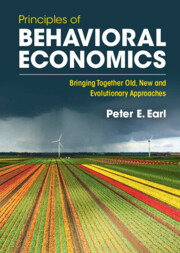28 results
Brendan Sheehan (2010) The Economics of Abundance: Affluent Consumption and the Global Economy Edward Elgar Publishing, Cheltenham, UK. pp.224 Hardback: ISBN 978 1 84376 670 4 RRP AUD 100
-
- Journal:
- The Economic and Labour Relations Review / Volume 23 / Issue 1 / February 2012
- Published online by Cambridge University Press:
- 01 January 2023, pp. 173-178
-
- Article
- Export citation

Principles of Behavioral Economics
- Bringing Together Old, New and Evolutionary Approaches
-
- Published online:
- 18 October 2022
- Print publication:
- 28 July 2022
Tables
-
- Book:
- Principles of Behavioral Economics
- Published online:
- 18 October 2022
- Print publication:
- 28 July 2022, pp xi-xii
-
- Chapter
- Export citation
Copyright page
-
- Book:
- Principles of Behavioral Economics
- Published online:
- 18 October 2022
- Print publication:
- 28 July 2022, pp iv-iv
-
- Chapter
- Export citation
10 - What Determines the Productivity of an Organization?
-
- Book:
- Principles of Behavioral Economics
- Published online:
- 18 October 2022
- Print publication:
- 28 July 2022, pp 295-338
-
- Chapter
- Export citation
Acknowledgments
-
- Book:
- Principles of Behavioral Economics
- Published online:
- 18 October 2022
- Print publication:
- 28 July 2022, pp xx-xxii
-
- Chapter
- Export citation
Contents
-
- Book:
- Principles of Behavioral Economics
- Published online:
- 18 October 2022
- Print publication:
- 28 July 2022, pp v-ix
-
- Chapter
- Export citation
6 - How Do We Search for Solutions to Problems?
-
- Book:
- Principles of Behavioral Economics
- Published online:
- 18 October 2022
- Print publication:
- 28 July 2022, pp 146-178
-
- Chapter
- Export citation
1 - What Is Behavioral Economics?
-
- Book:
- Principles of Behavioral Economics
- Published online:
- 18 October 2022
- Print publication:
- 28 July 2022, pp 1-24
-
- Chapter
- Export citation
11 - How Does the Competitive Process Work?
-
- Book:
- Principles of Behavioral Economics
- Published online:
- 18 October 2022
- Print publication:
- 28 July 2022, pp 339-387
-
- Chapter
- Export citation
8 - How Do We Choose?
-
- Book:
- Principles of Behavioral Economics
- Published online:
- 18 October 2022
- Print publication:
- 28 July 2022, pp 220-263
-
- Chapter
- Export citation
Figures
-
- Book:
- Principles of Behavioral Economics
- Published online:
- 18 October 2022
- Print publication:
- 28 July 2022, pp x-x
-
- Chapter
- Export citation
7 - Why Do Some Things Matter More Than Others?
-
- Book:
- Principles of Behavioral Economics
- Published online:
- 18 October 2022
- Print publication:
- 28 July 2022, pp 179-219
-
- Chapter
- Export citation
References
-
- Book:
- Principles of Behavioral Economics
- Published online:
- 18 October 2022
- Print publication:
- 28 July 2022, pp 470-498
-
- Chapter
- Export citation
9 - How Can Firms and Governments Influence Our Choices?
-
- Book:
- Principles of Behavioral Economics
- Published online:
- 18 October 2022
- Print publication:
- 28 July 2022, pp 264-294
-
- Chapter
- Export citation
Index
-
- Book:
- Principles of Behavioral Economics
- Published online:
- 18 October 2022
- Print publication:
- 28 July 2022, pp 499-518
-
- Chapter
- Export citation
12 - Are There Any Behavioral Insights for Macroeconomists?
-
- Book:
- Principles of Behavioral Economics
- Published online:
- 18 October 2022
- Print publication:
- 28 July 2022, pp 388-429
-
- Chapter
- Export citation
13 - Can We Be Happy without Destroying the Environment?
-
- Book:
- Principles of Behavioral Economics
- Published online:
- 18 October 2022
- Print publication:
- 28 July 2022, pp 430-469
-
- Chapter
- Export citation
3 - Why Is Life So Full of Problems for Us to Try to Solve?
-
- Book:
- Principles of Behavioral Economics
- Published online:
- 18 October 2022
- Print publication:
- 28 July 2022, pp 50-80
-
- Chapter
- Export citation
5 - How Do We Deal with Uncertainty and Ambiguity?
-
- Book:
- Principles of Behavioral Economics
- Published online:
- 18 October 2022
- Print publication:
- 28 July 2022, pp 119-145
-
- Chapter
- Export citation



